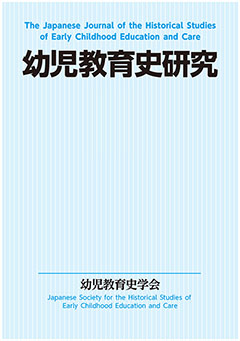最新号
選択された号の論文の19件中1~19を表示しています
- |<
- <
- 1
- >
- >|
表紙,目次
-
2023 年 18 巻 p. --
発行日: 2023年
公開日: 2024/03/21
PDF形式でダウンロード (455K) -
2023 年 18 巻 p. _-
発行日: 2023年
公開日: 2024/03/21
PDF形式でダウンロード (457K)
研究論文
-
2023 年 18 巻 p. 1-14
発行日: 2023年
公開日: 2024/03/21
PDF形式でダウンロード (843K) -
2023 年 18 巻 p. 15-26
発行日: 2023年
公開日: 2024/03/21
PDF形式でダウンロード (801K)
研究ノート
-
2023 年 18 巻 p. 27-40
発行日: 2023年
公開日: 2024/03/21
PDF形式でダウンロード (867K)
シンポジウム記録
-
2023 年 18 巻 p. 41-
発行日: 2023年
公開日: 2024/03/21
PDF形式でダウンロード (501K) -
2023 年 18 巻 p. 42-49
発行日: 2023年
公開日: 2024/03/21
PDF形式でダウンロード (732K) -
2023 年 18 巻 p. 50-54
発行日: 2023年
公開日: 2024/03/21
PDF形式でダウンロード (680K) -
2023 年 18 巻 p. 55-68
発行日: 2023年
公開日: 2024/03/21
PDF形式でダウンロード (928K) -
2023 年 18 巻 p. 69-72
発行日: 2023年
公開日: 2024/03/21
PDF形式でダウンロード (651K)
書評
-
2023 年 18 巻 p. 73-78
発行日: 2023年
公開日: 2024/03/21
PDF形式でダウンロード (639K) -
2023 年 18 巻 p. 79-83
発行日: 2023年
公開日: 2024/03/21
PDF形式でダウンロード (682K)
図書紹介
-
2023 年 18 巻 p. 84-87
発行日: 2023年
公開日: 2024/03/21
PDF形式でダウンロード (645K) -
2023 年 18 巻 p. 88-90
発行日: 2023年
公開日: 2024/03/21
PDF形式でダウンロード (620K)
学会会則・編集規程・投稿要領・論文審査手続き
-
2023 年 18 巻 p. 91-92
発行日: 2023年
公開日: 2024/03/21
PDF形式でダウンロード (552K) -
2023 年 18 巻 p. 93-94
発行日: 2023年
公開日: 2024/03/21
PDF形式でダウンロード (552K)
編集後記,機関誌編集委員会,奥付
-
2023 年 18 巻 p. 95-
発行日: 2023年
公開日: 2024/03/21
PDF形式でダウンロード (511K) -
2023 年 18 巻 p. 96-
発行日: 2023年
公開日: 2024/03/21
PDF形式でダウンロード (507K)
裏表紙, CONTENTS
-
2023 年 18 巻 p. __-
発行日: 2023年
公開日: 2024/03/21
PDF形式でダウンロード (455K)
- |<
- <
- 1
- >
- >|
